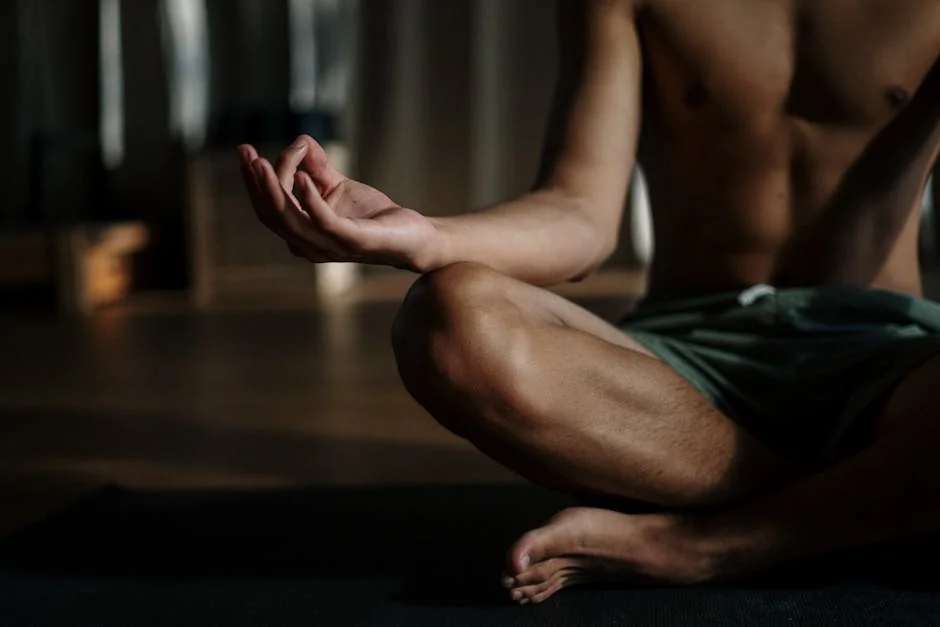Does your inner voice sometimes feel more like a harsh critic than a supportive friend? In a world that often tells us we need to be more, do more, and look a certain way, the quiet act of turning inward can feel like a radical rebellion. At its heart, meditation is a practice in self acceptance. It’s not about emptying your mind or achieving a state of perfect bliss; it’s about learning to sit with your entire experience—the chaotic thoughts, the difficult emotions, and all—without immediately trying to fix or judge them.
This is the first, crucial step toward truly befriending yourself. In this guide, we’ll explore how this powerful transformation happens. You’ll discover why simply observing your wandering mind is a profound act of acceptance, learn practical techniques to soften your inner critic, and find a simple meditation to begin weaving this compassionate approach into the fabric of your daily life. Ready to meet yourself with more kindness? Let’s begin.
What Does It Truly Mean to Accept Yourself?
Self-acceptance is not about resigning yourself to your flaws or giving up on growth. It’s not about deciding you’re perfect and have no need to change. True self-acceptance is the courageous act of acknowledging your present-moment reality, exactly as it is.
This means:
- Allowing yourself to feel sad, angry, or anxious without adding a layer of guilt.
- Noticing self-critical thoughts without believing they are the ultimate truth.
- Embracing your humanness, including your quirks and perceived imperfections.
It is a foundational state of being that says, "I am here, and I am worthy of kindness, right now." This is where the powerful combination of mindfulness and self-compassion begins.
The First Step: Observing Your Thoughts Without Judgment
Meditation trains you in the art of non-judgmental awareness. When you sit to meditate, you are not trying to stop your thoughts. Instead, you are learning to witness them. A thought about your to-do list arises. The practice is not to yell, "Go away, I'm meditating!" but to gently note, "Thinking," and return to your anchor, like the breath.
This simple act is revolutionary. By observing your inner world without getting swept away by it, you are sending a silent message to your psyche: "All of this is allowed to be here." You stop fighting your own mind. This shift from resistance to observation is the very essence of how meditation is a practice in self acceptance. If you're new to this process, our guide on how is meditation done can walk you through the fundamentals.
From Inner Critic to Compassionate Observer
As you practice observing, you can begin to soften the voice of your inner critic. When a harsh thought like, "I can't do anything right" arises, you can meet it with curiosity instead of contempt.
Try this self-compassion exercise:
- Acknowledge the pain. Silently say to yourself, "This is a moment of suffering."
- Connect to common humanity. Remind yourself, "I'm not alone; everyone feels this way sometimes."
- Offer kindness. Place a hand on your heart and ask, "What do I need to hear right now?" Perhaps it's, "It's okay. You're doing your best."
This approach, often cultivated through loving-kindness meditation, transforms your internal dialogue from one of criticism to one of support.
A Simple Meditation for Self Acceptance
Find a comfortable seat and set a timer for 5-10 minutes.
- Close your eyes and bring your attention to the physical sensation of your breath.
- After a minute, expand your awareness to include your entire body. Just feel the body sitting and breathing.
- When a thought or feeling arises, don't push it away. Imagine your mind as a vast, open sky, and thoughts as clouds passing through. Simply note "thinking" or "feeling" and return to the body.
- If you notice judgment, gently label it "judging" and return to your anchor. Each return is an act of acceptance.
- Before you finish, offer yourself a kind phrase, such as, "May I be kind to myself today."
Embracing Imperfection: How Meditation Redefines "Good" and "Bad" Sessions
A "good" meditation is not one free from thought. A truly successful session is one where you noticed your mind wandered—dozens of times—and patiently guided it back each time. The moment you notice you’ve been lost in thought is the magic moment of the practice. It’s not a failure; it’s a repetition that strengthens your ability to accept the imperfect, wandering nature of your mind.
Integrating Your Practice: Carrying Self-Acceptance Beyond the Cushion
The true power of this practice reveals itself off the meditation cushion. When you spill your coffee, can you meet your frustration with a sigh instead of self-flagellation? When you make a mistake at work, can you acknowledge it without spiraling into shame? This is the fruit of your practice. Each mindful breath during the day is a small, powerful reminder that you can meet your experience with openness and kindness, building a life rooted in self-acceptance. This is a core part of what meditation is good for—translating the calm from your practice into your everyday reactions.
Ultimately, the journey of meditation is a journey home to ourselves. It is not about achieving a state of perpetual calm or emptying the mind, but about learning to sit with our present-moment experience exactly as it is. Through the simple, repeated act of observing our thoughts, emotions, and bodily sensations without judgment, we cultivate a radical form of self-acceptance. This practice dismantles the exhausting cycle of self-criticism by teaching us that our worth is not contingent on being perfect, but on being authentically human. The true transformation occurs not when we change our thoughts, but when we change our relationship to them, fostering an inner sanctuary of compassion. This newfound acceptance then naturally extends outward, improving our interactions with the world. We invite you to begin this compassionate practice today, even for just a few minutes. Embrace each moment on the cushion not as a task to be perfected, but as an ongoing, gentle invitation to welcome every part of who you are.



